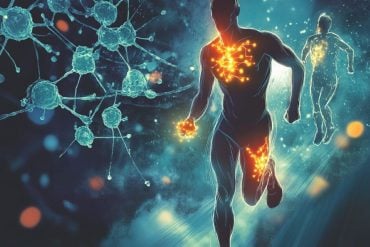Summary: BGE-175, an oral drug that reverses multiple aspects of immune aging effectively prevents death in mouse models of COVID-19.
Source: BioAge Labs
The immune system deteriorates with age, making COVID-19 particularly deadly in older people—but to date, no clinically available medication addresses this key risk factor.
A study published today in Nature shows that an oral drug that reverses multiple aspects of immune aging effectively prevents death in a mouse model of COVID-19, suggesting that the medication could be used to protect the elderly patients who are at greatest risk in the pandemic.
In the study, daily doses of BGE-175 (asapiprant) protected aged mice from a lethal dose of SARS-CoV-2, the virus that causes COVID-19. Ninety percent of mice that received the drug survived, whereas all untreated control mice died.
BGE-175 treatment was initiated two days after infection, when the mice were already ill, a time-frame relevant to real-life clinical situations in which patients would receive medication only after becoming symptomatic.
The mouse model used in the study closely mirrored the pathological progression of human COVID-19. The mouse-adapted strain of SARS-CoV-2 generated by the researchers caused a disease that shared many of the hallmarks of human COVID-19: accumulation of fluid in the air sacs of the lungs, extensive infiltration of lung tissue by immune cells, and high levels of pro-inflammatory factors called cytokines.
BGE-175 is currently in a Phase 2 clinical trial to test whether it can prevent disease progression and mortality in older patients hospitalized with COVID-19. BGE-175 is being clinically developed by BioAge Labs, a California-based biotechnology company devoted to creating drugs that treat human disease and extend healthspan by targeting the molecular mechanisms of aging.
“The COVID-19 pandemic has devastated elderly populations around the world,” said Kristen Fortney, Ph.D., CEO of BioAge and an author of the study.
“The promising preclinical data in this paper show that BGE-175 almost completely protects aged mice from lethality in a compelling model of human COVID-19. By reversing age-related declines in critical immune mechanisms, BGE-175 could allow older patients to more effectively fight off this disease.”
Reversing immune aging via a dual mechanism
As we age, a biochemical pathway involving the signaling molecule PGD2 becomes more active, impairing immunity in two major ways: First, antigen-presenting cells called dendritic cells migrate less efficiently, slowing the adaptive T-cell and antibody responses. Second, white blood cells called neutrophils infiltrate infected tissues more aggressively, leading to damaging inflammation.
Thus, the aged immune system is both slower to respond to new infections and more likely to overreact once it does mount a response.
BGE-175 inhibits this pathway by blocking the interaction between PGD2 and its receptor, a protein called DP1. BioAge’s AI-based drug discovery platform identified the PGD2-DP1 pathway as a key target for immune aging.
In the study described in the Nature paper, BGE-175 increased migration of dendritic cells from the lungs into the lymph nodes, decreased the levels of neutrophils in lung tissue, and dramatically improved overall survival. From the standpoint of PGD2 pathway activity, the drug restored the immune system to a more youthful state.
As with the drug-treated animals, genetically engineered mice that were unable to synthesize PGD2 or lacked DP1 had lower viral loads, exhibited less inflammation and tissue damage, and were less susceptible to death from viral infection, confirming that BGE-175 acts through the PGD2 pathway.
“Our findings clearly show that the therapeutic target of BGE-175 plays a key role in making the aged lung environment conducive for optimal immune function, and thereby counters immune aging,” said Stanley Perlman, MD, Ph.D., Professor of Microbiology and Immunology and Pediatric Infectious Physician at the University of Iowa, who was an author of the Nature paper.
“The drug’s protective effect in mice supports the idea that BGE-175 corrects age-related declines in immunity, providing a strong rationale for testing in older patients who are hospitalized with COVID-19.”
Clinical applications in human beings—for COVID and beyond
A Phase 2 clinical trial, initiated in March 2021, is testing whether BGE-175 can prevent respiratory failure and mortality in older patients hospitalized with COVID-19. Because some cases of COVID-19 are associated with uncontrolled inflammation, which increases disease severity and morbidity, the trial will also measure BGE-175’s effect on levels of inflammatory markers, providing insight into BGE-175’s ability to restore normal regulation of the immune system.
Antiviral drugs against COVID-19, as well as antibodies raised by vaccines, bind to specific viral proteins to exert their effect, and could therefore could lose efficacy if the SARS-CoV-2 virus continues to mutate—as already observed for the highly contagious omicron variant.
Because BGE-175 targets the host immune system rather than the invading virus, it has the potential to retain its efficacy against emerging strains that can resist antiviral drugs or evade vaccine-based immunity.

Similarly, because its mechanism of action is not specific to COVID-19, the drug could help older patients fight off other viruses. Consistent with this, in the Nature study, BGE-175 prevented lethality from SARS-CoV, the original SARS virus, which like SARS-CoV-2 also causes more severe disease in older animals.
“A properly functioning immune system is our first defense against any virus, and we know that age-associated immune abnormalities place the elderly at a much increased risk for death and complications from COVID-19,” said Eric Verdin, MD, President and CEO of the Buck Institute for Research on Aging, who was not involved in the study.
“New therapeutics that target age-associated pathways, especially those involved in immunity, will provide important tools for decreasing the burden of mortality and disability caused by COVID-19, as well as other infections that disproportionately harm the elderly.”
Pending positive results in the Phase 2 trial, BioAge intends to pursue broad clinical applications for BGE-175, including diseases such as influenza and viral pneumonia.
About this COVID-19 research news
Author: Press Office
Source: BioAge Labs
Contact: Press Office – BioAge Labs
Image: The image is in the public domain
Original Research: Closed access.
“Eicosanoid signaling blockade protects middle-aged mice from severe COVID-19” by Lok-Yin Roy Wong et al. Nature
Abstract
Eicosanoid signaling blockade protects middle-aged mice from severe COVID-19
Coronavirus disease 2019 (COVID-19) is especially severe in aged populations. SARS-CoV-2 vaccines are highly effective, but vaccine efficacy is partly compromised by the emergence of SARS-CoV-2 variants with enhanced transmissibility.
The emergence of these variants emphasizes the need for further development of anti-SARS-CoV-2 therapies, especially in aged populations.
Here, we describe the isolation of highly virulent mouse-adapted viruses and use them to test a novel therapeutic drug in infected aged animals. Many of the mutations observed in SARS-CoV-2 during mouse adaptation (positions 417, 484, 493, 498, 501 of the spike protein) also arise in humans in variants of concern (VOC). Their appearance during mouse adaptation indicates that immune pressure is not required for selection.
In murine SARS, in which severity is also age-dependent, elevated levels of an eicosanoid, prostaglandin D2 (PGD2) and of a phospholipase, PLA2G2D, contributed to poor outcomes in aged mice3,4. mRNA expression of PLA2G2D and PTGDR, a PGD2 receptor, and production of PGD2 also increase in human PBMC-derived dendritic cells with aging and after SARS-CoV-2 infection. Using our mouse-adapted SARS-CoV-2, we show that middle-aged mice lacking expression of PTGDR, or PLA2G2D are protected from severe disease.
Further, treatment with a PTGDR antagonist, asapiprant, protected aged mice from lethal infection. PTGDR antagonism is one of the first interventions in SARS-CoV-2-infected animals that specifically protects aged animals, suggesting that the PLA2G2D-PGD2/PTGDR pathway is a useful target for therapeutic interventions.






